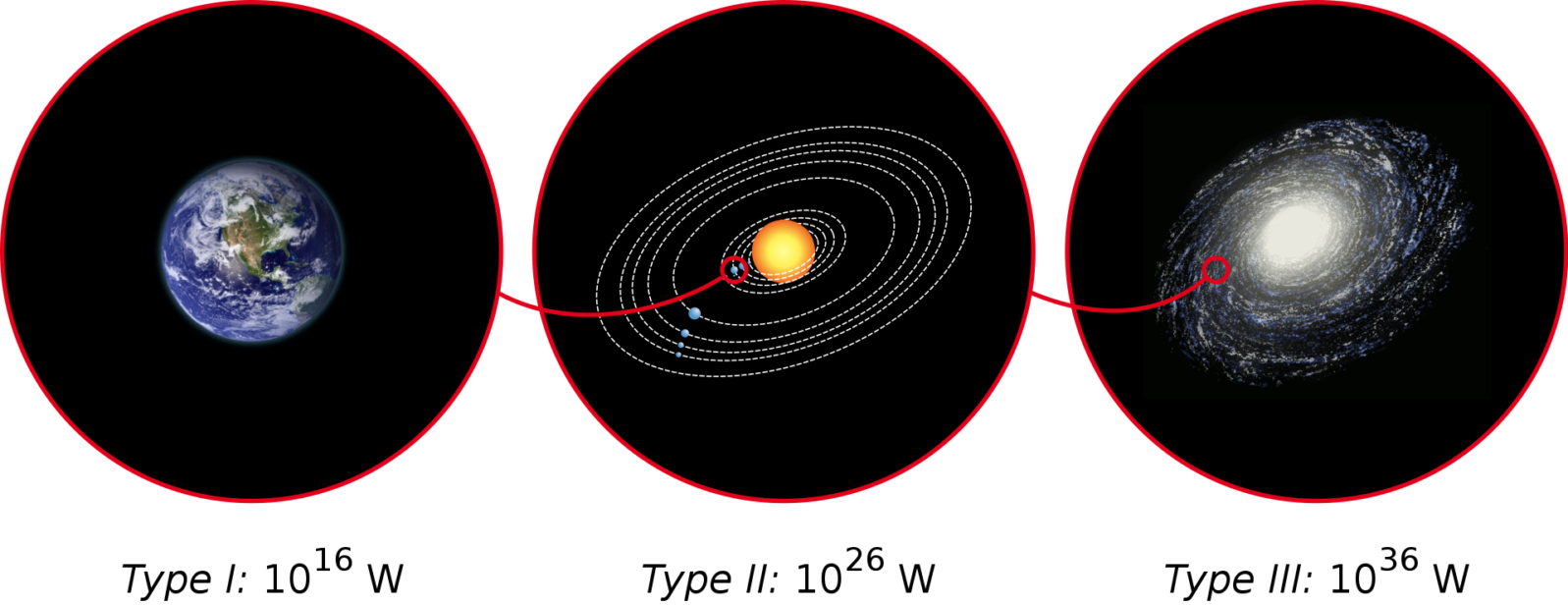Future Technologies — Zoom! … or Doom?
Astrophysicist Adam Frank sees a new role for us as galaxy gods as exhilarating but others aren’t so sureAstrophysicist Adam Frank asks us to consider where we are on the Kardashev Scale for evaluating civilizations in the galaxy — or, at least, evaluating our own progress: Originally proposed in 1964 by Nikolai Kardashev (1932–2019) and later modified in 1973 by Carl Sagan (1934–1996), the scale measures a civilization’s technological advances from 1 to 3 (or maybe 5) by how much energy it can call upon to do things.

Currently, we are not even a Type 1 on that scale and Frank offers some thoughts on that, asking, in particular, whether such advances are universal in the galaxy anyway:
The classification scheme Kardashev used was not based on social systems of ethics because these are things that we can probably never predict about alien civilizations. Instead, it was based on energy, which is something near and dear to the heart of anyone trained in physics. Energy use might provide the basis for universal stages of civilization evolution because you cannot do the work of building a civilization without using energy. So, Kardashev looked at what energy sources were available to civilizations as they progressed technologically and used those to build his scale.
Adam Frank, “Humanity is not even a Type 1 civilization. What would a Type 3 be capable of?” at Big Think (February 17, 2022)

We would be a Type 1 civilization if we could capture all the energy resources of our home planet, a Type 2 if we could similarly use our home star, and Type 3 if we could use the resources of our home galaxy. Greater feats are envisioned at even higher levels — for example, creating new universes.
Frank, however, sticks with the new galaxies in our existing universe: “And once we get to Type 3 civilizations, we are almost thinking about gods with the capacity to engineer entire galaxies.” He finds the prospect exhilarating:
For me, this is part of the point of the Kardashev scale. Its use for thinking about detecting technosignatures is important, but even more potent is its capacity to help us guide our imaginations. The mind can go blank staring across hundreds or thousands of millennia, and so we need tools and guides to focus our attention. That may be the only way to see what life might become — what we might become — once it arises to set out across the frontiers of space and time and possibility.
Adam Frank, “Humanity is not even a Type 1 civilization. What would a Type 3 be capable of?” at Big Think (February 17, 2022)
But science at the edges of science fiction is divided on the point. The Great Filter hypothesis is grimmer than the Kardashev scale: On that view, civilizations disappear somewhere between us and galaxy gods:
If it was very difficult to get from goo to zoo to you, not many space aliens have made it—thus they don’t exist, so we don’t hear from them. Alternatively, it was easy for them to get here, between 8 and 9, and it was here that something catastrophic happened … Which means that we might not get past this point ourselves either.
Of course, it’s possible that a catastrophe would not wipe out high-tech aliens but rather send them back to a sort of Stone Age. They’d still be out there but we’d need to find them. They’d be in no position to be looking for us. The sense of it is perhaps best given by a saying often attributed to, Albert Einstein is “I do not know with what weapons World War III will be fought, but World War IV will be fought with sticks and stones.” That sure takes the shine out of the “Boldly go ” from Star Trek…
In any event, theoretical physicist and futurist Michio Kaku thinks that the next hundred years will tell whether we are divine, dimmed, or doomed – Mind Matters News

Of course, there are other possibilities to consider: Advanced extraterrestrials may be out there but wisely avoiding us because of our violent tendencies:
As an example, Dr [Gordon] Gallup cites ‘the total destruction of the highly advanced Aztec and Inca civilizations’ and the subsequent genocide of the native people, their temples and buildings destroyed and their wealth and natural resources stolen.
‘If the humans of Earth became aware of advanced civilizations and desirable resources on other worlds, might these native extraterrestrial populations eventually suffer the same fate as befell the natives of Mexico and Peru?,’ he writes.
‘If there is intelligent life elsewhere, they may view humans as extremely dangerous. Maybe this is why there is no proof or compelling evidence of extraterrestrial intelligence: we pose too great a risk, and they do not want to be discovered.’
Jonathan Chadwick, “Is THIS why we’re yet to find aliens? Intelligent life may exist but be too SCARED of ‘dangerous’ humans to visit Earth, expert claims” at Daily Mail (February 24, 2022) The paper is open access.
This would be more in line with the Dark Forest Hypothesis about intelligent extraterrestrials. That view, riffing off the title of one of famed Chinese sci-fi author Liu Cixin’s novels, assumes that we can use sociology to figure out what extraterrestrial intelligences might be like or might want. Adam Frank disagrees. How much that we take for granted as “normal” is a product of human history and culture?
Another viewpoint, the Aurora Hypothesis, holds that “ET could have had only rare contact with us:
After factoring all of this into a series of simulations, they reached several conclusions. First, they [Adam Frank and Caleb A. Scharf, ] concluded that the time it would take for an exo-civilization to settle the galaxy is less than (or comparable to) the present age of the Milky Way (13.5 billion years). However, when one factors the “Aurora Effect” into the equation, it creates a scenario where only certain parts of the galaxy are settled.
Adding to that the notion that the lifetime of civilizations is finite, then it appears that certain clusters of the galaxy are destined to be settled and resettled while the surrounding areas will be unsettled. Last of all, if Earth is in a region of the galaxy that doesn’t correspond to a “resettlement cluster,” it’s entirely probable that we would not have been settled or visited for a long stretch of time – as much as 1 million years.
Matt Williams, “What is the Aurora Hypothesis?” AT UNIVERSE TODAY
Returning to Gordon Gallup for a moment, he thinks that, for more mundane reasons, “the prospect of finding technologically sophisticated intelligent life elsewhere exponentially remote.” It’s worth noting that, after centuries of modern science, we are just now looking for fossil bacteria on Mars — and not without risk, if we do find anything. ET may be in the same position.
The issue of contamination between worlds has been raised again recently as well:
In 1969, the sci-fi novel and movie The Andromeda Strain detailed what it would be like if a deadly alien microbe slipped onto Earth on a military satellite and the world had to deal with containing it. Although that’s a work of fiction, it’s not so far-fetched: In 2013, researchers described a new bacterial life form sharing less than 95 percent of its genetic sequence with its closest relative, baptized the Tersicoccus phoenicis (something like “cleanroom bug”) after being discovered in NASA and ESA spacecraft clean rooms thousands of miles apart.
Sofia Quaglia, “We’re Not Prepared for Contamination Between Worlds” at Gizmodo (February 20, 2022)
Many of us would prefer to see a string of movies and TV series first, exploring possibilities, before we boldly go.
You may also wish to read:
Most daring hypothesis yet: What if ET has morphed into what we now call the laws of nature? Astrophysicist Caleb Scarf has asked us to consider a daring hypothesis for conundrums around dark matter and dark energy. Scharf’s hypothesis highlights the genuine difficulty of accounting for a universe that comes into existence without any underlying intelligence at all.
Hat tip for the frightened aliens at the Daily Mail: Ken Francis, co-author with Theodore Dalrymple of The Terror of Existence: From Ecclesiastes to Theatre of the Absurd
